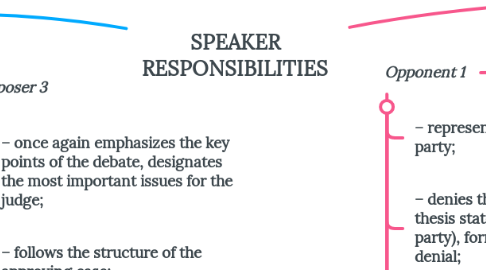
1. TEAM proposers
1.1. Proposer 1:
1.1.1. – represents the approving party;
1.1.2. – presents the topic (statement), substantiates its relevance;
1.1.3. – defines the terms (concepts) included in the topic;
1.1.4. – represents the point of view of the approving party;
1.1.5. – substantiates aspects of the consideration of this topic;
1.1.6. – presents the arguments of the approving party, which will be proved by the team during the game (in accordance with the aspects stated by the team);
1.1.7. – proceeds to the proof of the arguments put forward (if possible);
1.1.8. – ends with a clear statement of the general line of the approving party
1.1.9. – asks cross-questions O2
1.2. Proposer 2
1.2.1. – restores the point of view of the approving party with the help of hypotheses, examples and evidence;
1.2.2. – restores the approving case, position by position, following the original structure;
1.2.3. – provides new evidence (new evidence is welcome);
1.2.4. – repeats important aspects (criteria) of previous evidence;
1.2.5. – develops the approving position and the approving case in detail;
1.2.6. – refutes the denying case;
1.2.7. – no new arguments are given;
1.2.8. – ends with a clear statement of the general line of the approving party;
1.2.9. – answers O1 cross-questions.
1.3. Proposer 3
1.3.1. – once again emphasizes the key points of the debate, designates the most important issues for the judge;
1.3.2. – follows the structure of the approving case;
1.3.3. – returns to the criteria (aspects) put forward by P1 and explains how they confirm the position of the approving party;
1.3.4. – identifies vulnerabilities in the denial case;
1.3.5. – focuses on comparing approving arguments and negating arguments and explains why the approving arguments are more convincing;
1.3.6. – does not give new arguments;
1.3.7. – ends with a clear statement of the general line of the approving party (there may be less evidence in this speech than in others);
1.3.8. – asks questions O1.
2. TEAM opponents
2.1. Opponent 1
2.1.1. – represents the denying party;
2.1.2. – denies the topic (denies the thesis stated by the approving party), formulates the thesis of denial;
2.1.3. – accepts the definitions provided by the approving party;
2.1.4. – represents the position of the denying party;
2.1.5. – accepts aspects of the approving party or presents other aspects;
2.1.6. – represents the case of the denying party, the strategy of denial, i.e. the arguments of the negative side, which will be proved by the team during the game;
2.1.7. – refutes the arguments of the approving party put forward by P1;
2.1.8. – ends with a clear statement of the general line of the denying party;
2.1.9. – asks P2 cross-questions.
2.2. Opponent 2
2.2.1. – restores the denying party using hypotheses, examples and proofs;
2.2.2. – elaborates the denying party in detail, justifying the negative case;
2.2.3. – continues to refute the approving party;
2.2.4. – provides new evidence;
2.2.5. – does not give new arguments;
2.2.6. – ends with a clear statement of the general line of the denying party;
2.2.7. – answers P1 cross-questions.
2.3. Opponent 3
2.3.1. – conducts a comparative analysis of the positions of the parties on key issues;
2.3.2. – follows the structure of the negating case;
2.3.3. – identifies vulnerabilities in the approving case;
2.3.4. – focuses on comparing negating arguments and approving arguments and explains why negating arguments are more convincing;
2.3.5. – does not give new arguments;
2.3.6. – ends with a clear statement of the line of the denying party;
2.3.7. – asks questions of P1.
